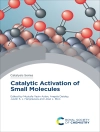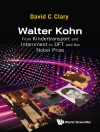Noncovalent interactions often provide the spine of biomolecular and material structures, and can therefore play a key role in biological and catalytic processes. Selectivity in chemical reactions, particularly in catalytic processes, is often an orchestral action of various noncovalent interactions occurring in intermediates and transition states. Although the role of hydrogen bonding is well explored in catalysis, the other types of weak interactions, namely cation–π, anion–π, π–π stacking, pseudo-agostic, halogen, chalcogen, pnictogen, tetrel and icosagen bonds, must also be considered. Naturally, the chemo-, regio- or stereoselectivity of a reaction depends on the stability of such noncovalent-interaction-supported species in catalytic systems. Therefore, an in-depth understanding of these weak interactions may be the key to designing new catalytic materials.
Providing an overview of the role of these different types of noncovalent interactions in both homogenous and heterogeneous catalysis, this book is a valuable resource for synthetic chemists who are interested in exploring and further developing noncovalent-interaction-assisted synthesis and catalysis.
Innehållsförteckning
Noncovalent Interactions in C–H Bond Functionalization;
Importance of C–H Hydrogen Bonding in Asymmetric Catalysis;
Catalysis by Networks of Cooperative Hydrogen Bonds;
Secondary (Agostic Si–H/Electrostatic C–F) Interactions in Alkaline Earth-based Catalysts;
Anion–π Catalysis;
Onium Ion-assisted Organic Reactions Through Cation–π Interactions;
The Role of Noncovalent Interactions in the Efficiency of Dendrimers in Catalysis;
Noncovalent Interactions in Hydrogenation and Hydroformylation;
Soft Forces in Organic Synthesis by C–N Coupling Reactions;
Noncovalent Interactions in the Design of Chiral Brønsted Acid Catalysts;
Noncovalent Interactions in the Nitroaldol (Henry) Reaction;
Noncovalent Interactions in Asymmetric Reactions Catalysed by Chiral Phosphoric Acids;
Baeyer–Villiger Oxidation Promoted by Noncovalent Interactions;
Noncovalent Interactionassisted Redox Catalysis in Reductive Dehalogenation;
Noncovalent Immobilization of Catalysts on Electrode Surfaces;
Noncovalent Interactions in Ionic Liquids;
Ionic Liquid Effect in Catalysed Multicomponent Reactions;
Noncovalent Interactions in Olefin Polymerization Catalysis Promoted by Transition Metals;
Influence of Noncovalent Interactions in Catalytic Ring-opening Polymerization Processes;
Cavity Effects in Metal–Organic Frameworks;
Cavity Effects in Metal–Organic Frameworks in CO2 Capture and Conversion;
Hybrids of Metal–Organic Frameworks as Organized Supramolecular Nano-reactors;
The Nature of Hydrogen Bonding in Adsorbed CO2 and H2O on Solid Amines in CO2 Capture;
Noncovalent Interactions of Biogenic Impurities with Transition Metal Catalyst Surfaces;
Mechanochemical Activation and Catalysis;
Role of Ion Pairing in the Mechanisms of Au(i)-catalysed Reactions: Theory and Experiment;
Noncovalent Interactions in Key Metal-centred Catalytic Intermediates: Structure– Electronic Relationship;
Noncovalent Interactions in Biocatalysis – A Theoretical Perspective;
Analysis of Reactivity from the Noncovalent Interactions Perspective
Om författaren
University of Lisbon, Portugal












